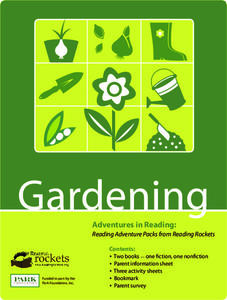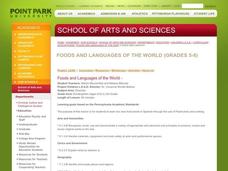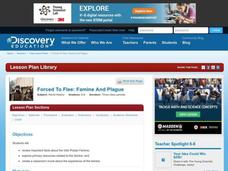Desert Discoveries
What's For Dinner?
Youngsters compare the teeth of plant-eating dinosaurs with those of meat-eating dinosaurs. The concepts of herbivore vs. carnivore are also introduced. There is an excellent worksheet embedded in the plan which shows five skulls of...
PBS
Reading Adventure Pack: Gardening
A Reading Adventure Pack invites scholars to start gardening. Following a reading of two books—fiction and nonfiction—young green thumbs repurpose food containers to grow an herb garden in their kitchen, plant seeds in starter pots out...
Curated OER
Kitchen Inspection Exercise
Students use a Department of Health Inspection Form to evaluate a kitchen/food prepartion facility as individuals or teams. They research prevention of food born illness during food storage and food preparation including Hazard Analysis...
Curated OER
Learning About the Food Chain
Learning about the food chain opens a Pandora's Box of opportunities to learn about endangered animals and the environment.
Winnipeg Health
Kids in the Kitchen
Too many cooks in the kitchen? Not here! Set up a cooking club at school using this 148-page guide that teaches food and kitchen safety, measurement techniques, and nutrition. Young chefs get their hands wet by participating in a variety...
Curated OER
Food Preservation
Students examine the different food canning methods and how to be safe canning. In this canning lesson students examine the hazards of improperly canning.
Curated OER
Introduction to Farming in the United States
Learners discuss basic foods and what constitutes a well-balanced meal. They identify four basic food groups, and identify food sources, such as farms.
Curated OER
Food Safety at the Grocery Store
Students study the connection between food spoilage and temperature control. They determine the difference between expiration, sell-by, and use by date on food. They investigate food safety practices to look for when food shopping.
Curated OER
Nutrition 2: Good Food, Good Health
Students examine how food provides them with energy and materials for their body. In groups, they identify good and bad foods to maintain a healthy lifestyle. Using the internet, they research how food can affect their overall health.
Curated OER
Track Your Food Today
In this food log worksheet, students analyze what they eat in a single day. Students fill in the chart for the food groups and the different meals and snacks consumed throughout the day.
Curated OER
Food and Languages of the World
Students listen to the story "No Blue Food" in this lesson plan. They then discuss Allegra, the main character, and her hesitation to try new foods. They participate in a matching game in which they match cards to determine a fruit...
Curated OER
Foods and Languages of the World
Students review Mexico's location and language and learn to pronouns 10 new Spanish food words. Students listen as the book, Corn is Maize is read, touching and passing around an ear of Indian corn. Students discuss the contribution of...
Curated OER
Primary Sources: Diaz and Cortes
Provided are two descriptions, both from famous Spanish explorers. Pupils read each passage and then answer 2 inference questions based on how they think each description shows what Cortes and Diaz felt about the Aztecs. Show images of...
Curated OER
Who Eats Who?
Students recognize that some animals eat plants, some eat meat and some both. For this who eats who lesson, students chart animals in a food chain. Students research information from reading articles. Students chart what animals eat...
Curated OER
Responsible Eating
Students identify healthy eating habits. For this nutrition lesson, students discuss the food pyramid and healthy food choices. Students track their daily food intake in a journal.
Curated OER
Striking a Balance
Students simulate animals in a food chain. In this food chain lesson plan, students are identified as grasshoppers, frogs or hawks. Popcorn is spread across a lawn and students are given baggies (stomachs) and colored sashes to identify...
Curated OER
Owl Pellets
Sixth graders investigate the role of owls in their ecosystem. In this food chain lesson, 6th graders illustrate an owl food chain, dissect an owl pellet, and analyze data. Students discuss what would happen to owls if there were an...
Curated OER
Forced to Flee: Famine and Plague
Students examine facts about the Irish Potato Famine and explore primary resources, such as newspaper articles, photographs, songs, and poems, related to the famine. Once research is complete, they create a small collage of their...
Curated OER
Food From Around the World
Students identify foods from around the world. In this multicultural lesson, students use Internet resources to research a specific country and the foods which are popular. Students collect a single recipe to combine with recipes from...
Curated OER
Plant Science Chapter #1
It may not stand as a cohesive presentation, but individually you may find a use for these slides. One slide describes how civilization began once man learned to plant and harvest food. Another explores the population growth over time....
Curated OER
Renewable Energy Sources
Place learners into groups to research and present different renewable energy sources. As individuals listen to the class presentations, they take notes and then write a persuasive article defending the form of energy that they feel...
DePaul University
Contrast and Evaluate Fact and Opinion
How can you tell when an author is expression an opinion or stating a fact? Use two short reading selections to emphasize the difference between a statement that you can prove and one that you can't. The first passage explains food...
Montana State University
Everest Extremes: Biodiversity
How many animals can live in a climate as cold as Mount Everest's? Find out with a science instructional activity all about biodiversity. Activities include research, presentations, group work, coloring maps, and a simulation of a food web.
Curated OER
What is Biotechnology?
Young consumers explore the concept of biotechnology as it pertains to the foods they eat, economics, and agriculture. They watch several videos, explore a website, complete worksheets, and engage in class discussion. Son they'll know...

























